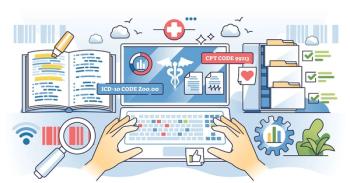
Detailed Coding in ICD-10 Avoids Revenue Headaches
Avoid problems with reimbursement through accurate and specific coding in ICD-10. Here are some tips to do that.
During the first week of ICD-10 implementation, an orthopedic practice received a sudden spate of claim denials from Medicare. The agency cited invalid codes, but an internal review didn’t find any obvious errors. It took careful sleuthing to figure out what was going wrong.
“The practice had about 60 denials coming in all at once for similar types of services,” says Deborah Grider, CPC, past president of the Indiana Health Information Management Association and a frequent speaker and consultant on ICD-10 implementation. “When we tracked the claims, we found that a software glitch at the clearinghouse was causing the seventh character of the ICD-10 codes to drop off automatically, causing Medicare to deny the claims.”
The clearinghouse rectified the issue immediately, but the problem could have persisted without timely follow-up, she says. It’s just one example of the importance of ensuring accurate and specific coding under the new system, something not all clinicians took seriously in the months leading up to implementation.
“Over the past six months, I’ve been training physicians non-stop because a lot of practices have waited until the last minute,” says Grider. “Many physicians are beginning to realize just how much accurate documentation and coding is tied to their revenue under ICD-10.”
One of the biggest challenges is adjusting to the specificity of the new diagnosis codes. Physicians who deal with a lot of injuries, for example, like the aforementioned orthopedic practice, must be well-versed in the use of the seventh character extender that specifies the type of encounter, such as initial (active treatment), subsequent (routine care during recovery) or sequela (complications).
ICD-10 codes also call for much more precise descriptions of the site of an injury or disease compared to ICD-9 coding, experts say. That’s putting more pressure on physicians to provide detailed documentation and communicate with coders.
“Physicians need to include enough detail in their documentation for coders to make an appropriate assessment of what codes to use,” says Pamela Jodock, senior director, health systems solutions, for the Health Information and Management Systems Society. “If coders are continually going back to ask providers for more information, you’re going to see delays in reimbursements.”
To minimize such delays, Jodock and Grider offered the following tips:
Limit use of unspecified codes. Coding a complaint as unspecified is sometimes justified but it may also point to insufficient documentation, which can cause a denial. For example, an insurer might deny a claim for removal of impacted cerumen in the ear if the code fails to specify the patient’s right, left, or both ears.
Run frequency reports. Run monthly reports showing what codes your practice uses most frequently, noting any overuse of unspecified codes. For example, ICD-10 increases the number of codes that apply to chest pain, requiring more detailed documentation by cardiologists. Therefore, consider it a red flag if every claim filed for chest pain that month uses an unspecified code.
Customize your coding. Many practices are relying on their EHRs to guide them to the correct ICD-10 diagnosis code, but that can cause problems, notes Grider. For example, one of her clients, part of a large multispecialty group, found that when coding for deep vein thrombosis, their system prompted them to specify the right or left side but not the upper or lower extremity. As a result, the system defaulted to acute thrombosis when in fact the majority of patients should have been coded at the chronic level. To avoid that scenario, she suggests creating a list of search terms that apply specifically to the conditions seen most often in your practice.
Communicate. Keeping the lines of communication open between clinicians and coders can help make workflow more efficient. The better providers understand the level of documentation needed to file an accurate claim, the less time coders will spend going back to them for clarification.
Newsletter
Optimize your practice with the Physicians Practice newsletter, offering management pearls, leadership tips, and business strategies tailored for practice administrators and physicians of any specialty.











